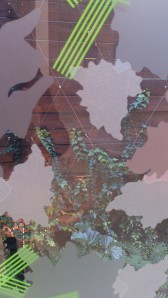Hi there!
It has been quite some time since I’ve seen the work of Suji Park, and since I’ve last written, but the end half of 2016? Yeah… Anyway, I was very excited to catch her latest exhibition at Ivan Anthony Gallery with its fantastically onomatopoeic title, oo0O0oo0O0oo0O0oo, which continues with her foray into experimentation, process and material.
With tactile, textured surfaces that have been decorated, studded, doodled, moulded, Park’s sculptures are the subjects of her playful inquisitiveness; an inquisitiveness that is conferred upon her creations. Many have small, curious faces that beckon you to lean in and look closer. Some of which you genuinely have to, as they are displayed low on the wall below hip height. Works such as Saii (2016, oil, acrylic and crystals on fired clay) and Ori (2016, oil, tempera and gold on fired clay) resemble unearthed idols or relics: intricately and lovingly detailed, and made semi-precious with the inclusion of crystals and gold. I was quite intrigued by Saii, who bears a passing resemblance to the Grinch, and there is something familiar about a few of the figures (perhaps from Miyazaki?).
Park has utilised a gamut of materials in this exhibition: oil, graphite, clay, feathers, watercolour, tempera, synthetic hair, garnet, quartz, the list goes on. These are best seen on the trestle table, a cornucopia of curiosities, with smatterings laid out amongst her sculptures. Though seemingly displayed at random, they are not as arbitrary as initially thought. The feathers, black crystals, small iridescent discs and so on, are presented just so, possibly implying that the works are unfinished and we are only seeing them mid-process. There is an abundance of detail to submerse yourself in as you weave through the four rooms of the gallery, down to the red fingernails of Aah (2016, oil, tempera, watercolour, graphite, gold and pigment on fired clay) and a single braid of synthetic hair.
This melding and mixing of materials in her work is fascinating. Park has brought together finished and unfinished substances such as fired and unfired clay, and painted in tempera, a traditional medium made from colour pigments and egg, used for religious icons since the early centuries AD. Her process of experimenting investigates the processes themselves, as she breaks the materials down and sees what else they can become. There are a liberating number of potentialities and forms that her work can take on; they have chimeric qualities, and this adds an element of the unknown and the unexplored. You do wonder as you glimpse upon them at this moment, what they will look like over time – will some of the elements fracture, break, sprout or disintegrate?
There is a lot to captivate with Park’s exhibition, and I recommend taking in the splendour with a bit of sun gleaming in through the windows. That way you can enjoy the glint and grooves of the materials that make up her sculptures, in particular Dol Vii (2016, fired clay, non-firing clay, unfired clay, epoxy, garnet, mica, plastic, glass, acrylic, watercolour, tempera, quartz, chipped foam and plaster) as there is a lot going on there 😛
For images of the works, please see the gallery website:
http://www.ivananthony.com/suji-park-oo0o0oo0o0oo0o0oo-1
oo0O0oo0O0oo0O0oo by Suji Park is on at the Ivan Anthony Gallery, near the corner of East St and K’Rd until Thursday 23rd February 2017. Park has also released a publication, Original Unknown with images of her work thus far, and essays by Charlotte Huddleston, Emma Bugden and Karl Chitham. It is available from the Ivan Anthony Gallery.
Thanks for reading!
M.







